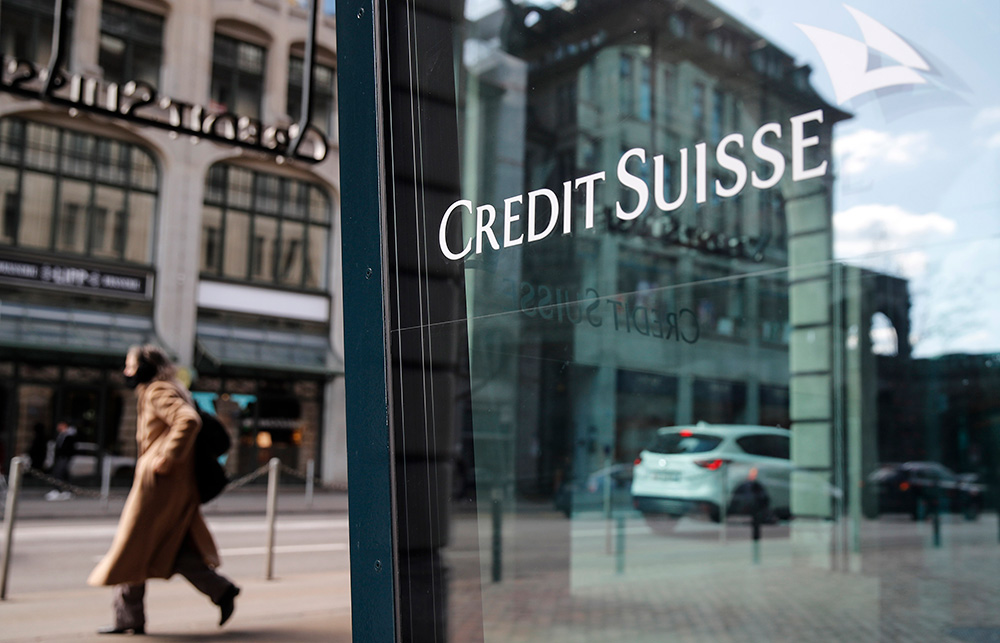
攪動華爾街的對沖基金Archegos Capital Management再爆驚人消息,預計將導致瑞士信貸損失50億瑞士法郎(約合55億美元),一次虧掉相當于投行部門5年的利潤。
投資者也懲罰了該股票,周四蘇黎世開盤股票便下跌了4.5%。
周四,丑聞纏身的瑞士銀行通過強制可轉債出售了2.03億股股票。瑞信表示與比爾·黃旗下對沖基金相關交易尚未完全平倉,預測二季度可能出現6億瑞士法郎(合6.56億美元)的相關虧損。
出售股票之前的三個月里,瑞信已計入44.3億瑞士法郎費用,導致出現7.57億瑞士法郎的虧損,不過比最初擔心的數額要少。
首席執行官高曦泰表示,紐約大宗經紀業務造成的損失“不可接受”,認為問題根源在于Archegos運作不透明。
“很明顯,類似的家族辦公室并沒有像普通對沖基金一樣披露頭寸,”高曦泰告訴記者。“我們將向監管機構了解其他公司的管理方式。”
長期資本陰影再現
上個月底,摩根大通預計銀行業與Archego相關的損失或將增加到100億美元。不過,野村和摩根士丹利等交易對家都估計,他們各自的損失與瑞信相比要少很多。
“這次事件很特殊。從規模和后果而言,銀行業上次遇到類似的情況還是長期資本管理公司(LTCM),”周四,瑞信首席財務官大衛·馬瑟斯談到上世紀90年對沖基金長期資本崩潰時對分析師表示。
盡管一季度承銷業務激增,投行業務表現強勁,瑞信還是啟動了戰略評估以降低投行部門的杠桿率和資產規模。
瑞信表示,今年引發Archegos災難的大宗經紀業務可能將縮減三分之一,只負責最重要的客戶,不過相關客戶與其他業務有很大重疊。
大宗服務業務的吸引力向來不大。“我們從來沒覺得這塊業務回報率很高,”高曦泰表示。
瑞信發行了兩種可轉換為約8.3%流通股的票據以支撐資產負債表。預計可籌集約17億瑞士法郎凈收入,也確保覆蓋虧損的資本遠高于償付能力監管的最低門檻。
“我們希望不用再討論資本狀況,”瑞信首席執行官對記者表示。他補充說,此舉也能避免瑞信受市場動蕩和通脹擔憂的影響。
Greensill Capital倒閉后,Archegos迅速爆出虧損消息,也迫使瑞信清算投資基金,目前與資不抵債的供應鏈金融公司相關資產已高達100億美元。
如今,在曾經所謂安全的短期投資方面,客戶損失可能高達數十億美元。盡管如此,管理層仍表示出現贖回潮的可能性不大。首席財務官馬瑟斯表示,3月該公司三個財富管理部門的凈新增資產均為正值,此前公司已撤出對Greensill funds的投資。
瑞信并未排除在損益表中額外費用增加的可能性,當季已出現3000萬美元的減記,主要涉及向Greensill提供的過橋貸款。
更令投資者不安的是,周四瑞士金融監管機構FINMA表示,因瑞信牽扯到Archegos和Greensill崩盤已對其啟動強制執行程序。
大清掃
本月早些時候,公司對相關交易逐一展開調查,取消了高管獎金,擬議股息削減了三分之二。投行部門負責人布萊恩?陳和風險與合規部主管勞拉?華納也被迫離職。
然而,兩人離任對高曦泰的影響相當負面。之前他曾親手提拔陳(Chin),還宣布今年夏天華納的職責范圍將覆蓋一項增效計劃,目標是明年起每年節省最多4.5億瑞士法郎。現在看來,該項增效計劃對公司未來非常關鍵,因為Archegos相關的損失相當于10年的資金儲備。
之后不久,頑強的高曦泰發誓要與5月新上任的董事長安東尼奧?奧爾塔-奧索里奧一起,牢牢掌控局面。
安東尼奧?奧爾塔-奧索里奧目前在勞埃德銀行集團擔任首席執行官,很適合這份新工作。迄今為止今年全球最大的兩起金融事件中,瑞信都遭到波及。
瑞信的命運迅速惡化。就在六個月前,一直苦苦忍受的股東還對公司前景抱有光明的希望。由于三季度業績穩健,去年10月底瑞信決定依照瑞士監管機構的要求,支付2019年扣下的剩余一半股息。
瑞信也恢復了因疫情暫停的股票回購,打算今年再撥出10億瑞士法郎。此后股價一路大漲,幅度高達50%,但今年早些時候,暫停進一步回購股票等消息不斷傳出,漲勢逐漸回落。
截至4月下旬,瑞信過去半年的漲幅已基本抹平。(財富中文網)
更新,2021年4月22日:本文已更新來自瑞信的評論。
攪動華爾街的對沖基金Archegos Capital Management再爆驚人消息,預計將導致瑞士信貸損失50億瑞士法郎(約合55億美元),一次虧掉相當于投行部門5年的利潤。
投資者也懲罰了該股票,周四蘇黎世開盤股票便下跌了4.5%。
周四,丑聞纏身的瑞士銀行通過強制可轉債出售了2.03億股股票。瑞信表示與比爾·黃旗下對沖基金相關交易尚未完全平倉,預測二季度可能出現6億瑞士法郎(合6.56億美元)的相關虧損。
出售股票之前的三個月里,瑞信已計入44.3億瑞士法郎費用,導致出現7.57億瑞士法郎的虧損,不過比最初擔心的數額要少。
首席執行官高曦泰表示,紐約大宗經紀業務造成的損失“不可接受”,認為問題根源在于Archegos運作不透明。
“很明顯,類似的家族辦公室并沒有像普通對沖基金一樣披露頭寸,”高曦泰告訴記者。“我們將向監管機構了解其他公司的管理方式。”
長期資本陰影再現
上個月底,摩根大通預計銀行業與Archego相關的損失或將增加到100億美元。不過,野村和摩根士丹利等交易對家都估計,他們各自的損失與瑞信相比要少很多。
“這次事件很特殊。從規模和后果而言,銀行業上次遇到類似的情況還是長期資本管理公司(LTCM),”周四,瑞信首席財務官大衛·馬瑟斯談到上世紀90年對沖基金長期資本崩潰時對分析師表示。
盡管一季度承銷業務激增,投行業務表現強勁,瑞信還是啟動了戰略評估以降低投行部門的杠桿率和資產規模。
瑞信表示,今年引發Archegos災難的大宗經紀業務可能將縮減三分之一,只負責最重要的客戶,不過相關客戶與其他業務有很大重疊。
大宗服務業務的吸引力向來不大。“我們從來沒覺得這塊業務回報率很高,”高曦泰表示。
瑞信發行了兩種可轉換為約8.3%流通股的票據以支撐資產負債表。預計可籌集約17億瑞士法郎凈收入,也確保覆蓋虧損的資本遠高于償付能力監管的最低門檻。
“我們希望不用再討論資本狀況,”瑞信首席執行官對記者表示。他補充說,此舉也能避免瑞信受市場動蕩和通脹擔憂的影響。
Greensill Capital倒閉后,Archegos迅速爆出虧損消息,也迫使瑞信清算投資基金,目前與資不抵債的供應鏈金融公司相關資產已高達100億美元。
如今,在曾經所謂安全的短期投資方面,客戶損失可能高達數十億美元。盡管如此,管理層仍表示出現贖回潮的可能性不大。首席財務官馬瑟斯表示,3月該公司三個財富管理部門的凈新增資產均為正值,此前公司已撤出對Greensill funds的投資。
瑞信并未排除在損益表中額外費用增加的可能性,當季已出現3000萬美元的減記,主要涉及向Greensill提供的過橋貸款。
更令投資者不安的是,周四瑞士金融監管機構FINMA表示,因瑞信牽扯到Archegos和Greensill崩盤已對其啟動強制執行程序。
大清掃
本月早些時候,公司對相關交易逐一展開調查,取消了高管獎金,擬議股息削減了三分之二。投行部門負責人布萊恩?陳和風險與合規部主管勞拉?華納也被迫離職。
然而,兩人離任對高曦泰的影響相當負面。之前他曾親手提拔陳(Chin),還宣布今年夏天華納的職責范圍將覆蓋一項增效計劃,目標是明年起每年節省最多4.5億瑞士法郎。現在看來,該項增效計劃對公司未來非常關鍵,因為Archegos相關的損失相當于10年的資金儲備。
之后不久,頑強的高曦泰發誓要與5月新上任的董事長安東尼奧?奧爾塔-奧索里奧一起,牢牢掌控局面。
安東尼奧?奧爾塔-奧索里奧目前在勞埃德銀行集團擔任首席執行官,很適合這份新工作。迄今為止今年全球最大的兩起金融事件中,瑞信都遭到波及。
瑞信的命運迅速惡化。就在六個月前,一直苦苦忍受的股東還對公司前景抱有光明的希望。由于三季度業績穩健,去年10月底瑞信決定依照瑞士監管機構的要求,支付2019年扣下的剩余一半股息。
瑞信也恢復了因疫情暫停的股票回購,打算今年再撥出10億瑞士法郎。此后股價一路大漲,幅度高達50%,但今年早些時候,暫停進一步回購股票等消息不斷傳出,漲勢逐漸回落。
截至4月下旬,瑞信過去半年的漲幅已基本抹平。(財富中文網)
更新,2021年4月22日:本文已更新來自瑞信的評論。
The stunning implosion of Archegos Capital Management, whose speculative bets roiled Wall Street, is now expected to cost Credit Suisse an even 5 billion francs ($5.5 billion), wiping out in one fell swoop five years of profits at its investment banking division.
Investors punished the stock, sending shares down 4.5% at the open Thursday in Zurich.
The scandal-plagued Swiss lender, which sold 203 million shares via mandatory convertibles on Thursday, said it had not yet fully unwound trades connected with Bill Hwang’s hedge fund and forecast further related headwinds of 600 million francs ($656 million) for the second quarter.
This comes on top of the 4.43 billion francs charge booked in the first three months of the year, pushing the group 757 million francs into the red, albeit less than initially feared.
Chief executive Thomas Gottstein called the losses generated by its New York prime brokerage operation "unacceptable" but blamed the opaque nature of Archegos for the problem.
“It's clear that a family office like that did not disclose positions like a normal hedge fund would do," Gottstein told reporters. "We will also learn from the regulators how other firms had managed."
Echoes of long-term capital
At the end of last month, JP Morgan raised its forecast for the banking sector’s collective Archego losses to $10 billion. Rivals Nomura and Morgan Stanley have estimated their respective hit to be a fraction of Credit Suisse’s, however.
“It is an exceptional event. I think the last time the industry has seen anything like this was LTCM in terms of its size and consequence,” Credit Suisse chief financial officer David Mathers told analysts on Thursday, referring to the collapse in the 1990s of hedge fund Long-Term Capital Management.
Despite an otherwise strong underlying Q1 performance in investment banking led by a surge in underwriting, Credit Suisse initiated a strategic review with the aim of slimming the division’s leverage and assets.
The prime brokerage activities responsible for the Archegos disaster could shrink by a third over the course of this year to focus only on the bank’s most important clients who have large overlaps across the rest of its operations, it said.
Prime services were never a very attractive part of the business. "It is definitely not a business per se that we ever felt was extremely high returning," Gottstein said.
Credit Suisse shored up its balance sheet by issuing two notes convertible into roughly 8.3% of its outstanding shares. This will raise an estimated 1.7 billion francs in net proceeds and bolster its loss-absorbing capital well above regulatory minimum thresholds for solvency.
"We wanted to take the whole capital debate off the table," the Credit Suisse CEO told reporters, adding it would also protect the bank against volatile markets and inflationary fears.
The Archegos loss followed swiftly on the heels of the collapse of Greensill Capital, forcing Credit Suisse to liquidate investment funds, whose $10 billion in assets were linked to the now insolvent supply-chain finance firm.
Clients now face potentially billions in losses on what were supposedly safe, short-term investments. Nonetheless, management said there was no indication the bank might face a wave of redemptions. Net new assets in each of its three wealth management divisions were positive in March, according to finance chief Mathers, after it froze investors out from the Greensill funds.
Credit Suisse didn’t rule out additional charges to its income statement, either, already booking in a $30 million write-down in the quarter related to a bridge loan to Greensill.
Adding to investor jitters, the Swiss financial watchdog, FINMA, said on Thursday it has opened enforcement proceedings against the bank for its role in the Archegos and Greensill collapses.
Cleaning house
Earlier this month, investigations were launched into each affair, bonuses for the C-suite were eliminated, and the proposed dividend slashed by two-thirds. It also cost the job of both the division’s head, Brian Chin, and risk and compliance boss Lara Warner.
Their departures, however, cast a negative light on Gottstein. He promoted Chin to the role and expanded Warner’s remit this summer as part of an efficiency plan designed to save up to 450 million francs annually from next year. This looks to be a now fateful decision as Archegos-related losses will eat up a decade of those planned savings.
A defiant Gottstein vowed shortly afterward to stay on to right the ship together with the new chairman of the board come May, António Horta-Osório.
The current CEO of Lloyds Banking Group has his work cut out for him: Amid the two single biggest global financial debacles so far this year, Credit Suisse found itself in the middle of both.
Credit Suisse's fortunes have soured quickly. Only six months ago, the outlook was brightening for the bank’s long-suffering shareholders. On the back of solid third-quarter results, it decided at the end of October to pay out the remaining half of the 2019 dividend cut at the request of Swiss regulators.
It simultaneously resumed share buybacks suspended because of the pandemic and earmarked a further billion francs for this year. The move marked the beginning of a 50% surge in the stock price, but the rally petered out earlier this year amid a steady stream of news, including the suspension of further stock repurchases.
As of late April, Credit Suisse has relinquished almost all its gains made in the past half-year.
Update, April 22, 2021: This article has been updated with comments from Credit Suisse throughout.






